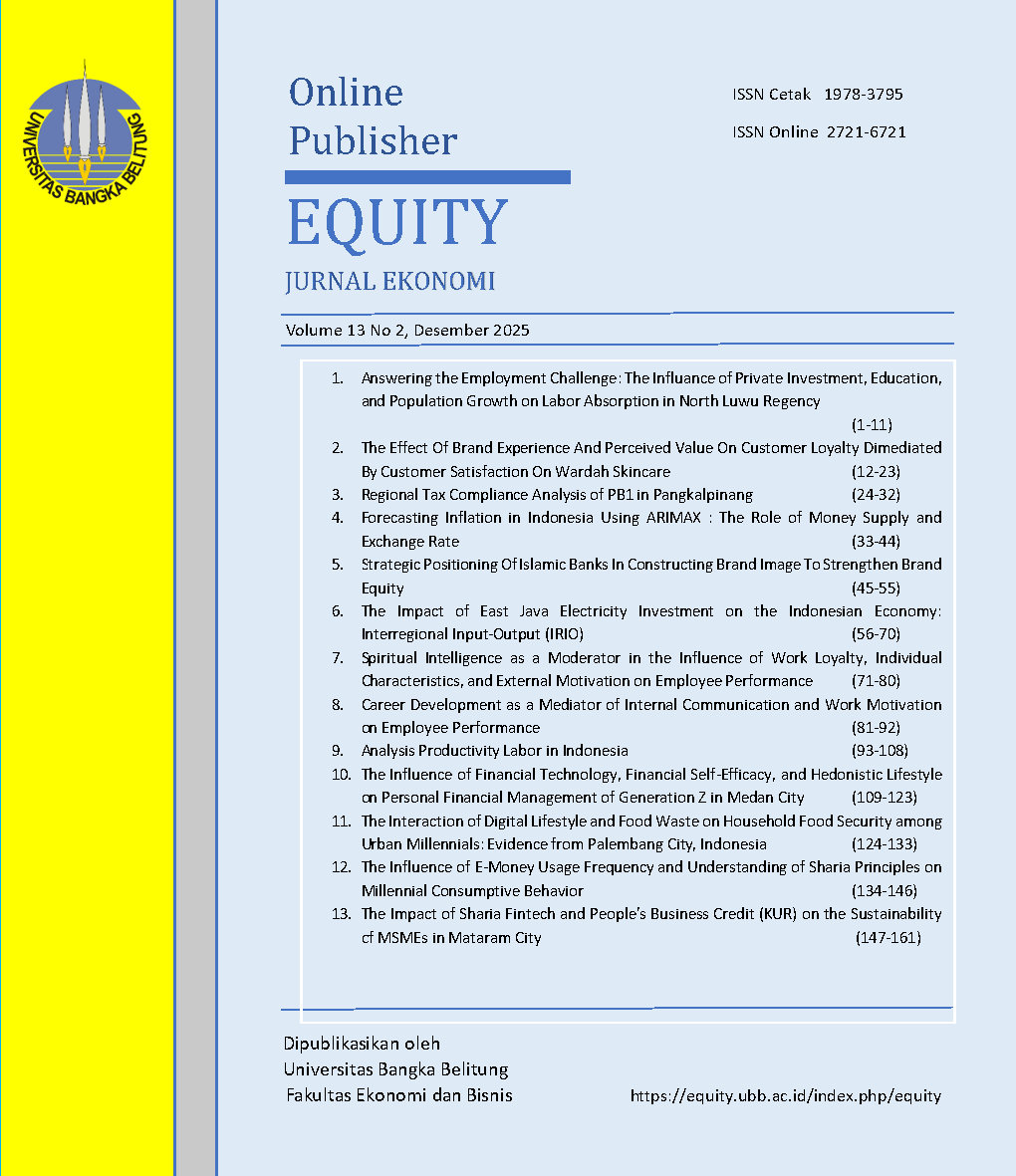Forecasting Inflation in Indonesia Using ARIMAX : The Role of Money Supply and Exchange Rate
DOI:
https://doi.org/10.33019/equity.v13i2.370Keywords:
Inflation Rate, Money Supply, Exchange Rate, Forecasting, ARIMAXAbstract
Inflation is an essential economic indicator since it signals rising prices for goods and services. Economic factors influence Indonesia's inflation rate, including the money supply and exchange rate. These factors can have an impact not only on inflation at a single point in time but also throughout time. The money supply and exchange rate are two economic factors that substantially influence inflation. As a result, it is critical to forecast Indonesia's inflation rate using money supply and exchange rate as input variables. This study examines the effect of the money supply and exchange rate on the inflation rate. The data used is monthly from 2021-2023 sourced from Bank Indonesia (SEKI BI). This study used the Autoregressive Integrated Moving Average with Exogenous Factor (ARIMAX) technique. The results reveal that the ARIMAX (0,2,1) accurately predicts inflation, as seen by MAPE values of 9.48%. The results also show that the money supply and exchange rate significantly affect the inflation rate in Indonesia. This is due to the impact of the COVID-19 pandemic on Indonesia, which has caused the inverse effect of the exogenous variables. The ARIMAX model can be a valuable and efficient tool for improving forecasting.
Downloads
References
Adão, B., & Silva, A. C. (2021). Government financing, inflation, and the financial sector. Economic Theory, 71(4), 1357–1396. https://doi.org/10.1007/s00199-020-01303-y
Akinsola, F. A., & Odhiambo, N. M. (2017). Inflation and Economic Growth: A Review of the International Literature. Comparative Economic Research, 20(3), 41–56. https://doi.org/10.1515/cer-2017-0019
Amhimmid, O. M. H., Yanto, H., & Setyadharma, A. (2021). The Effect of Interest Rates, Money Supply and Exchange Rate on Inflation in Indonesia and Libya. Business and Economic Analysis Journal, 1(2), 104–121. https://doi.org/10.15294/beaj.v1i2.33590
Bank Indonesia. (2022). Transformasi Bauran Kebijakan Dan Akselerasi Ekonomi Keuangan Digital. Laporan Perekonomian 2021, 112–115. https://www.google.com/url?sa=i&rct=j&q=&esrc=s&source=web&cd=&ved=0CAIQw7AJahcKEwiIrejkpcX_AhUAAAAAHQAAAAAQAw&url=https%3A%2F%2Fwww.bi.go.id%2Fid%2Fpublikasi%2Flaporan%2FDocuments%2FLPI_2021.pdf&psig=AOvVaw0gYXIUY8FBZUIYsLP8UnVq&ust=1686919174694011
Bina, A., Rahmadana, M., & Yusuf, M. (2023). The Analysis of Factors Affecting Inflation in Indonesia. 8(1). https://doi.org/10.4108/eai.1-11-2022.2326164
Cili, M. R., & Alkhaliq, B. (2022). Economic Growth and Inflation: Evidence from Indonesia. Signifikan: Jurnal Ilmu Ekonomi, 11(1), 145–160. https://doi.org/10.15408/sjie.v11i1.19848
Coker, M. (2025). Short-Term Inflation Forecasting In Sierra Leone: A Comparison of Vector Autoregressive VAR(P), Arimax, And Arima Models. SSRN Electronic Journal, 13(05), 9090–9111. https://doi.org/10.2139/ssrn.5289305
Eksiandayani, S., Suhartono, & Prastyo, D. D. (2015). Hybrid Arimax-Nn Model for Forecasting Inflation. International Conference on Science, Technology and Humanity 2015, 181–187.
Jamil, M. N., Rasheed, A., Maqbool, A., & Mukhtar, Z. (2023). Cross-cultural study the macro variables and its impact on exchange rate regimes. Future Business Journal, 9(1), 1–15. https://doi.org/10.1186/s43093-023-00189-1
Jin, Z., Wang, H., & Zhao, Y. (2021). Macroeconomic Impact of Foreign Exchange Intervention: Some Cross-country Empirical Findings. IMF Working Papers, 2021(126), 1. https://doi.org/10.5089/9781513571959.001
Junia, Ri. F. (2023). Analysis of the Influence of Exports, Imports, and the Rupiah Exchange Rate on Indonesian Foreign Exchange Reserves Period 1990-2020. Proceeding of 3rd International Conference on Islamic Economics, Islamic Finance, & Islamic Law (ICIEIFIL) in Conjunction with 3rd International Conference on Islamic and Muhammadiyah Studies (ICIMS), January, 11–12.
Kongcharoen, C., & Kruangpradit, T. (2013). Autoregressive Integrated Moving Average with Explanatory Variable (ARIMAX) Model for Thailand Export. 33rd International Symposium on Forecasting, South Korea, June, 1–8. http://www.researchgate.net/publication/255731345_Autoregressive_Integrated_Moving_Average_with_Explanatory_Variable_(ARIMAX)_Model_for_Thailand_Export/file/9c9605209ac48013f6.pdf
Kurniasih, E. P. (2019). The long-run and short-run impacts of investment, export, money supply, and inflation on economic growth in Indonesia. Journal of Economics, Business, & Accountancy Ventura, 22(1), 21–28. https://doi.org/10.14414/jebav.v22i1.1589
Markus, I., & Muchtar, P. A. (2023). The Global Economic Outlook and the State of Indonesia. ERIA: Economic Research Institute for ASEAN and East Asia, 2020(2022), 1–5.
Newton, N., Kurnia, A., & Sumertajaya, I. M. (2020). Analisis Inflasi Menggunakan Data Google Trends Dengan Model Arimax Di Dki Jakarta. Indonesian Journal of Statistics and Its Applications, 4(3), 545–556. https://doi.org/10.29244/ijsa.v4i3.694
Oktavia, V., & Wahyudi, S. (2022). The Effect of BI Rate and Exchange Rate on Inflation in Indonesia with the Money Supply as a Mediating Variable. Jurnal Penelitian Ekonomi Dan Bisnis, 7(1), 46–54. https://doi.org/10.33633/jpeb.v7i1.4305
Osagie Adenomon, M., & Oshuwalle Madu, F. (2023). Comparison of the Out-of-Sample Forecast for Inflation Rates in Nigeria Using ARIMA and ARIMAX Models. Time Series Analysis - New Insights, December. https://doi.org/10.5772/intechopen.107979
Pangestuti, D. C., Fadila, A., & Nugraheni, S. (2022). Rupiah Exchange Rate Fluctuations in The US Dollar, Purchasing Power Parity Theory and Fisher Effect Theory Testing. Nominal Barometer Riset Akuntansi Dan Manajemen, 11(1), 79–97. https://doi.org/10.21831/nominal.v11i1.42982
Pratiwik, E., & Prajanti, S. D. W. (2023). Rupiah exchange rate: the determinants and impact of shocks on the economy. Jurnal Ekonomi & Studi Pembangunan, 24(1), 100–126. https://doi.org/10.18196/jesp.v24i1.18016
Rukini. (2015). Model ARIMAX Dan Deteksi GARCH Untuk Peramalan Inflasi Kota Denpasar Tahun 2014. Jurnal Ekonomi Kuantitatif Terapan, 7(2), 44321.
Shafira, E. I. (2023). Analisis Pengaruh Jumlah Uang Beredar Dan Bi Rate Terhadap Inflasi Di Indonesia Periode 2011-2018. 3(2), 85–94. http://repository.ekuitas.ac.id/handle/123456789/1955
Siregar, A. A., Afiff, A. Z., & Halim, R. E. (2023). Linking agile leadership and business sustainability through the mediation of political and social capabilities. Journal of Open Innovation: Technology, Market, and Complexity, 9(4), 100153. https://doi.org/https://doi.org/10.1016/j.joitmc.2023.100153
Stavrakeva, V., & Tang, J. (2023). A Fundamental Connection : Exchange Rates and Macroeconomic Expectations. CEPR Discussion Paper, 20.
Sugandi, E. A. (2022). Indonesia’s Financial Markets and Monetary Policy Dynamics Amid the COVID-19 Pandemic. In Asia-Pacific Financial Markets (Vol. 29, Issue 3). Springer Japan. https://doi.org/10.1007/s10690-021-09354-4
Sumiyati, E. E. (2022). Macroeconomic Factors and Current Account Deficit in Indonesia. Journal of Economics and Business, 5(4), 8–18. https://doi.org/10.31014/aior.1992.05.04.455
Yilmazkuday, H. (2022). Inflation and growth: the role of institutions. Journal of Economics and Finance, 46(1), 167–187. https://doi.org/10.1007/s12197-021-09563-7
Downloads
Published
Issue
Section
License
Copyright (c) 2025 Besti Novianda

This work is licensed under a Creative Commons Attribution 4.0 International License.
Authors who publish journals in Equity: Jurnal Ekonomi agrees with the following conditions:
1. Authors retain copyright and grant the journal right of first publication with the work simultaneously licensed under a Creative Commons Attribution 4.0 International License.
2. Authors are able to enter into separate, additional contractual arrangements for the non-exclusive distribution of the journal's published version of the work (e.g., post it to an institutional repository or publish it in a book), with an acknowledgement of its initial publication in this journal.
3. Every publication (printed/electronic) are open access for educational purposes, research, and library. Other than the aims mentioned above, the editorial board is not responsible for copyright violation.













